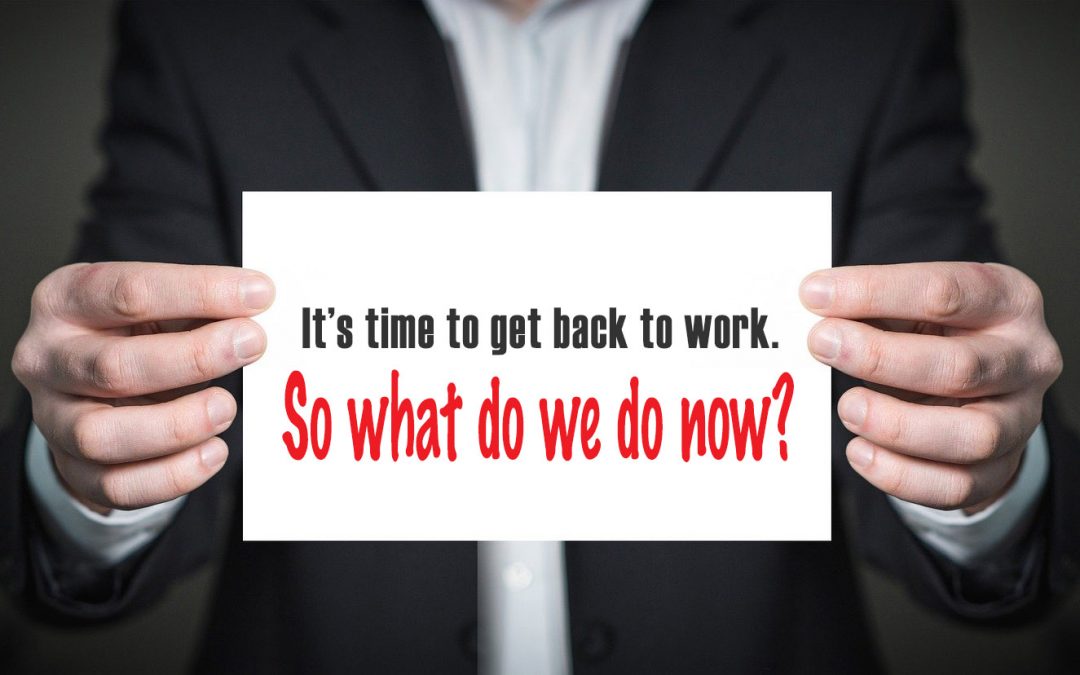Every industry has been struggling since the coronavirus became global news. From the time the virus began and was isolated to China, manufacturing and B2B services took a hit as imports were halted and trade shows were canceled all over the United States. Since making it stateside, more and more businesses have been adversely affected. This culminated in a majority of local governments closing nonessential businesses and limiting those that are still in operation.
Even those who are still providing their products and services have been hurting, due to lowered economic activity as a whole. This has made many business owners and decision-makers fearful. With no definite end date in sight, businesses are worried about having enough liquidity to make it through to the end. Not only is this a problem with the virus, but also a problem with consumer expectations. In many markets, the outlook for the rest of 2020 looks rather dim. Some industries have seen a decrease in volume by over 50%. The general consensus for the rest of the year, it would seem, is not optimistic.
That being said, any entrepreneur who manages or owns a business knows that reacting to a situation is not enough. One must be proactive to survive and even thrive. In the coming months, the market for perhaps even the next decade will be shifted into a new direction. Pieces are being rearranged. How your business performs throughout the coming months and years depends on your decisions right now.
To help you meet this challenge, the digital marketing team at Adams Media Group has been hard at work. We have come up with comprehensive and data-driven strategies for a number of industries. These are to both help you sustain business today, and build prospects for tomorrow. While it is good to be cautious, fear itself cannot be the motivating factor. Find your industry below, and let’s get started.
Retail
Many customers are looking for assurance that they will be safe when shopping at your stores. Show your customers that you take their concerns seriously. Post or advertise images of your employees wearing face masks and using plastic shields at checkout. Share branded graphics explaining health and safety guidelines for shopping during the pandemic. Assure customers that baskets, shopping carts, and other public use objects are cleaned after each use. Also, promote store policies regarding slowing the spread of the coronavirus.
You should also limit the number of people who can enter your store at a time. Encourage customers to shop midday or later in the evening to stagger traffic. You can additionally set exclusive hours for seniors so that they might be able to shop while avoiding the crowd.
For the more practically-minded, promote times that are usually slower for your stores as “low-traffic” times. This will encourage customers who want to avoid the crowd to visit during these times.
We know items like toilet paper, Clorox, and hand sanitizer are in high demand. Advertise that you are limiting customers to buying only two bulk items at a time. This assures customers that you likely have the item in stock, and they are more likely to come in. It reflects positively on your image, as well. It shows you care more about serving more people, not only in selling the items quickly. It is also more profitable to sell to a greater number of people than to sell to an individual. This is because people are also liable to make additional purchases while in-store.
Non-essential retail, take note. Even when the economy reopens, many people may still feel uncomfortable about shopping in general. This is especially true for conjoined stores in shopping malls. Advertise what efforts you will be taking to limit the spread of coronavirus, even after the economy reopens. Clean surfaces regularly and post online what methods you’re using to keep customers safe.
Offer “slow-the-spread” discounts for anyone wearing a face mask and gloves in-store. The discount itself is not the main driver for customers, though. It is a signal to those who see your posts or ads online that your customers will probably be wearing a mask and gloves. This will help alleviate some fears for those thinking of returning once you open your doors.
Think about what frequent customers may be missing from your store being closed. Sure, many customers may buy products online. Yet brick-and-mortar will always offer some benefit that Amazon can’t match.
Clothing stores can show ads of customers trying on a number of new seasonal dresses. Stores that sell electronics can promote trade-in options for old devices. For any brick-and-mortar store, customer service is a big sell. Show ads with real employees engaging with customers. Ads with people after a period of social distancing have performed better than ads without.
Food Service
Takeout or delivery has been the new lifeblood for many restaurants. If this is the case for you, make ordering from your website as easy as possible. Have your DoorDash, UberEats, and other delivery links present and easily visible on your website. You can also support this by updating your listings on Google My Business, Yelp, and beyond. Your customers looking up nearby takeout or delivery might not even know you’re providing it if they don’t see it in the Maps app.
You can further support your delivery and takeout options on social media. Promote your delivery and takeout options frequently to local areas, with 5-10 miles. Paid ads for your business can reach past customers with the news that you’re open, and still serving your community.
Though a decline in business is to be expected, if you are looking to maintain steady orders throughout the crisis, your customers should know what you’re doing to slow the spread. Pin a post to your pages on social media explaining your business’ guidelines for preparing food during the pandemic. Your customers may want to order from you, but don’t know how the food is prepared. Operate under the assumption that your customers don’t know if you’ve made any changes at all since the start of the spread. Many are simply fearful of infection and can be swayed if you show them your process. Photos of your employees in face masks and gloves can go a long way to assuaging fears. You can also share what methods you have in place for social distancing among employees and customers alike.
For fine dining, coffee shops, and others who don’t offer takeout, you should be working hard to hit the ground running when you reopen your doors. Photography or videography can be great content for your social media. Especially with no customers in the store, you have an opportunity to capture a new perspective of your process.
Now that there’s some downtime, you can also try crafting new dishes for your menu. There is plenty of time for your head chef to create new recipes and teach your staff. Then, go ahead and advertise your new mouth-watering additions to your followers and beyond. For those living on their own cooking or frozen food, remind them that they’ve been missing a fresh meal. Then, when it comes time to reopen, promote the date and time of your reopening to the same audience.
A simple, but effective tactic: sell “date night certificates” with a special deal for when restaurants are allowed to open their doors. This helps put money in your pocket today and can generate interest for your business leading up to your opening. Plus, a proper date night is something many couples have been missing.
Realtors
For real estate agents, coronavirus has been a twofold hit. Clients and potential buyers alike have slowed down. Therefore, it is best to approach the issue from these two fronts.
To find a prospective home buyer now is the time to build the relationship that leads to a sale in a few months. Approaching such prospects can be most easily done through visual media. Promote and schedule virtual open houses. Live-streaming this content allows for a more authentic, personal interaction with an audience. Sellers are also more receptive to tours if they are done virtually. The trend continues to support digital presence versus a real presence. This type of content is prioritized in feeds on social platforms like Facebook, as well.
For your current clients, consider this an opportunity for new photos or videos. The lowered interest rates from the crisis could encourage a surge of buyers once all this settles down. Your risk is not in necessarily having a shortage of clients. Your struggle may be in getting the attention of future buyers. So having interactive 360 images, drone walkthroughs, and more could give help build rapport with these buyers today.
Those looking to expand their current list of clients may already have noticed a soft market. Nervous sellers needed confidence before the coronavirus; now, it’s as uncertain as ever. Easing concerns for the general market can be done in a number of ways. Try advertising toward potential sellers how much you sold other, similar homes. Specific dollar amounts per size of the home narrow your audience to your ideal type of client. Additionally, you can connect with home buyers and market the type of home they’re looking for. With a market only growing in buyers and not sellers, buyers may stick around longer with their realtor. For you, this means you have an opportunity to advertise and connect with sellers with a buyer already in hand.
Personal Care
Barbers, salons, gyms, and spas have all but completely ceased operations amid coronavirus. Even when you reopen your doors, it may not be easy to see how to inspire consumer confidence. Close contact with others in a public place is already a tough sell, especially when you add interacting with customer-facing service providers and sharing seats, equipment, and accommodations with strangers.
Inspiring confidence by sharing your own guidelines for avoiding the spread of coronavirus is not going to be sufficient. No matter what protocols you have in place, the reality of personal care services cannot be avoided. Plus, many of the same procedures are already in place for sanitary reasons. If a customer is aware of this, they may not be so keen on sharing space.
The way to bring in customers is not by reassurance alone. Think about what they might want if they did indeed stop in. It’s simple, customers who really want to visit you want a return to normalcy. After weeks or months without a haircut or manicure, customers may just want to feel pampered. The way to convince them to come in won’t be to show your staff in a hazmat suit, then.
Connect with your customers in a real way. Advertise your business and empathize – for salons, something like this: “Split ends? Fading color? Grey hair? Let’s get you back to your gorgeous self.” Gyms can try something similar – “Home quarantine can make any of us feel a bit out of shape. Let’s get back into shape before we go back into the office.”
In the meantime, between now and opening back up for business, offer deals for customers if they book a reservation now versus later. A percentage discount on all services, if they book them ahead of time, can put money in your pocket today, and ensure business further down the line. Additionally, these customers will be more flexible since they would be booking without a date. When you open, you can offer times more prudently than having a flood of customers all at once on Day 1.
Airports
Perhaps the hardest hit of industries on this list. Managing an airport has always been a matter of margins. There’s also not necessarily a lot of liquidity for airports to take hits for months at a time. Many employees, like air traffic controllers, can’t be cut or furloughed for long without delaying their return. Airports find that expenses are hard to reduce without also reducing future viability.
For these types of clients, what matters now is getting through to the end of the state of emergency. Business flights are almost certain to pick up shortly once the economy opens again. Not to the degree they were before, but enough that it is a manageable decrease.
Two things are not liable to change so quickly, though. First, vendors that struggle and pull out of an airport during this crisis are huge hits to an operating budget. Beyond just losing their tenancy, it also devalues the flying experience. This is a rapid spiral that is best avoided. Second, recreational slights are doubtful to make a comeback this year. This can’t be avoided per se. Many areas have proposed travel restrictions throughout the rest of the year, like India and China.
What can be done is a shift in focus. Many airports have relied on acting as a marketing arm for tourism to their location. This relies on steady recreational travel. As business travel will become a more common reason for travel, prioritizing this type of travel becomes essential. One method of doing so is advertising to other businesses, like a B2B. Offer bulk deals and establish relationships with local businesses to fly with you. Reach out to those in your network, especially those with relationships to your current vendors. Becoming a center for business travel now will help boost traffic while avoiding the hit down the line from the loss in recreational travel.
Apart from this, airports can seek out non-local travel by advertising on social media for flights to their location. LinkedIn, for instance, has little competition in this industry or in-feed ads. Such ads were once seen as ineffective, but this is a changing market that could last for the better half of a year. For airports of any size, promoting business travel and offering safe, sanitized spaces is something none have opted to try as of yet on social media. After 2001, new times called for new strategies. Likewise in 2020, ingenuity will be rewarded; the alternative is stagnation.
Marketing During The Coronavirus, By Industry
If you’re in manufacturing, B2B, transportation, or a related industry, check out Secret to B2B Marketing for our detailed advice. The strategies we lay out there are more comprehensive and couldn’t be fit into just one article.
Are you in the trade profession? Legal group? Consultation? Entertainment? Something else entirely? We want to give you our personalized advice. Give us a call at 772.492.6570 or send us an email and let’s set up a time for your free marketing audit and hear our advice. Let’s work to make your business stronger and endure coronavirus. Let’s get through this crisis together.



